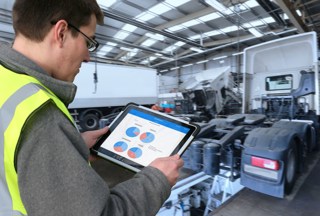First impressions count. Whether someone is going along to a job interview or an important business appointment, if they turn up looking like they’ve been dragged through a hedge backwards then the meeting is unlikely to progress well.
The same is true for an organisation: if the car or van an employee arrives in at a customer’s premises is damaged or filthy, it could impact adversely on that company’s reputation.
“To us, having a clean and well-maintained vehicle is essential,” says Nick Webb, fleet manager of Millers Vanguard, which supplies and maintains equipment to the food service industry.
“The first impression any store will have of us is when our vehicle arrives in its car park. It’s like a business card for us, so it has to be pristine and if it looks unsightly to us, we will change the vehicle.
“We work in the hygiene industry, so customers expect that a prestigious organisation like us, which is turning up to clean, service or repair catering equipment, must adhere to the same standards they do.”
However, while its appearance may be the most obvious sign of a well-cared for and maintained vehicle, there are a number of other significant benefits to fleets.
The most obvious one is reduced costs, says Peter Eldridge, director of ICFM. These manifest themselves in a number of ways: reduced in-life service, lower maintenance and repair (SMR) costs, reduced end-of-contract penalty charges and enhanced residual values.
“The difference between a well-looked after fleet and one that isn’t could easily improve the bottom line on a balance sheet by a six-figure sum for a 750-vehicle fleet,” he adds.
Many fleets have found that fitting telematics has enabled them to reduce in-life costs. “One of the benefits is that drivers treat the vehicles better because their driving behaviour is being monitored and improved,” says Webb. “If they treat the vehicles better, there is less wear and tear and fewer accident repairs.”
Anglian Water aimed to cut fuel use by 10% through improved driver behaviour when it embarked on a telematics programme in 2014.
In the first year it fitted the technology to 750 vans, the second to 500, with the remaining vans on its 1,640-strong fleet receiving the equipment last year.
The organisation saw a typical 10-13% improvement in economy across the fleet, meaning it has saved more than £650,000 in fuel costs.
However, head of fleet services Stewart Lightbody saw another beneficial side effect: the improved driver behaviour reduced Anglian Water’s tyre costs by £10,000 a month and its insurance premium by £60,000 a year.
Private hire company Greentomatocars also turned to telematics to cut its accident costs through improved driver behaviour. It has fitted the technology to 300 vehicles and last year made savings of £600,000.
“The saving was not only due to the telematics,” says Sophie Jacobsen, head of service delivery at Greentomatocars. “It was also due to performance management of the drivers following an internal reorganisation, but telematics did have a huge impact on us.”
As well as reduced in-life costs, taking care of vehicles also has a beneficial effect at the end of fleet life. “A failure to maintain a vehicle in good condition is likely to significantly impact on residual values and, if leasing, end-of-contract damage charges which can be a contentious issue,” says John Pryor, chairman of fleet operators’ association ACFO.
Significant area of costs
Last year’s FN50 research, which covers the UK’s 50 largest contract hire and leasing businesses, found that the average end-of-contract damage charges were £289 for cars and £380 for vans, making it a significant area of cost to fleets.
However, this can be reduced by ensuring vehicles are properly maintained and better cared for during fleet life.
Britvic, for example, has seen its average end-of-contract damage charges fall from around £900 some four years ago to £287 last year through employees taking better care of their cars (see page 40), and Wakefield District Housing has an average bill of £30 per van thanks to its approach to vehicle care (see page 38).
Fleets which buy outright will find cars or vans sold at auction with damage will attract less interest and lower bids, while ongoing vehicle care should also extend to ensuring that no documents or items such as spare keys go missing.
BCA estimates that the typical costs of missing items are £500 for service history, £100 for a spare key, rising if it is a car with keyless entry or a programmable key, and £50 for a missing spare tyre or repair kit.
Any missing documents may also lead to a delay in the vehicle being sold while eplacements are sourced.
While taking care of vehicles will positively impact a company’s bottom line, Eldridge says the other main benefit of ensuring a fleet is well looked after is the reduction in exposure to operational road risk.
“Quite simply, if a fleet operator promotes poor disciplines with the routine elements of the vehicle operation, then this could be conveyed as a green light to allowing poor driving standards and behaviour, with the inevitable outcome of increased accident rates and costs,” he says.
“Worse still, it could lead to penalisation under ‘cause and permit’ legislation, which is geared to fines being imposed to the business as a percentage of their turnover.”
Pryor adds: “Compliance with occupational road risk best practice and health and safety regulations means maintaining vehicles in accordance with manufacturer recommendations. There is no cost cap that can be put on that as any failure could result in significant damage – cost and reputational – and injury or even death to drivers and the public.
“Ultimately, a company car or van is company property and should be looked after as any property belonging to an organisation would be.”
Invest in staff and companies will reap the rewards
Looking after company vehicles well can help an organisation get more out of its staff.
As well as portraying a professional image of a business, well-cared for cars or vans can make drivers feel more valued, improving staff morale and performance.
“We feel that if we invest in staff, in return we get good service from them,” says Liam Farrar, fleet manager at Wakefield District Housing, which has a comprehensive vehicle care programme.
“Because our guys are lone workers, the van is also their office and they appreciate that we are investing in them, so we are seeing that the vehicles are in a better condition and we tend to have less damage.”
The programme covers areas such as repairs, vehicle cleaning and driver training.
“We want people to go home safe, we don’t want them to be in accidents or go to hospital or be off work,” adds Farrar.
Chairman of Fleet Industry Advisory Group Geoffrey Bray adds: “There is a correlation between the attitude to vehicle care of a company and the fleet decision-maker and the way a fleet performs and what it looks like. Cars and vans are expensive assets so they must be looked after.”
Case study: Britvic/Millers Vanguard on engaging drivers and giving drivers a sense of ‘ownership’
Giving drivers an increased feeling of ownership by offering them a wide choice of car or getting them involved in speccing their van can improve the way they treat their vehicle.
Britvic offers its company car drivers an open choice list which, within their band, gives them the opportunity to select a brand they want, with the option to make a monthly contribution to trade up to a more prestigious, higher-specced low-CO2 car.
By making this choice, the employee tends to be better off by “probably £300 or £400 a year”, says director of compensation and benefits Will Smith, as despite making the contribution and that car having a higher P11D value, the employee benefits through lower BIK tax bills and private fuel cost.
It also gives them a vehicle they want to look after, he adds. The company has seen average end-of-contract recharges fall by around two-thirds from £800 to £900 around five years ago to £287 now.
“If you give someone something they are proud of, they will take better care of it and this principle applies to cars,” says Smith.
“If drivers make a contribution towards a car, then they’ve got a financial attachment to it outside of tax and they have a car they are proud of. We find that they take care of these vehicles significantly better than they would otherwise.
“They keep them clean, they ensure they are serviced regularly and any scrapes or bumps are reported promptly.”
Millers Vanguard also involves employees in speccing vehicles, for example making changes to internal lighting on the suggestion of an engineer.
“Asking for ideas and listening to them makes the drivers feel they’ve got input into the vehicle and that their voice is being heard,” says Nick Webb, of Millers Vanguard.
“It makes them think about the vehicle they are driving and gives them the feeling of ownership.”





















Login to comment
Comments
No comments have been made yet.